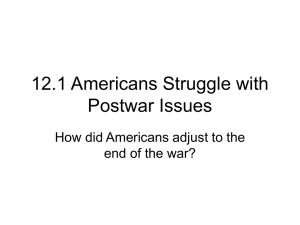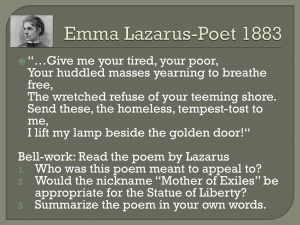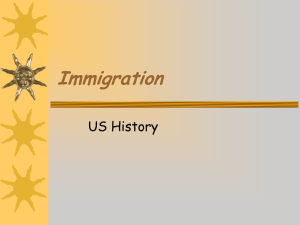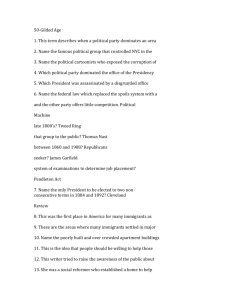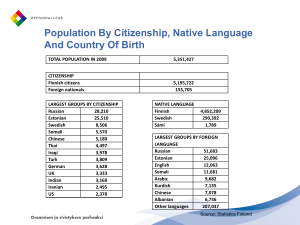Parent Letter for Week of: January 25 * 29, 2010
advertisement
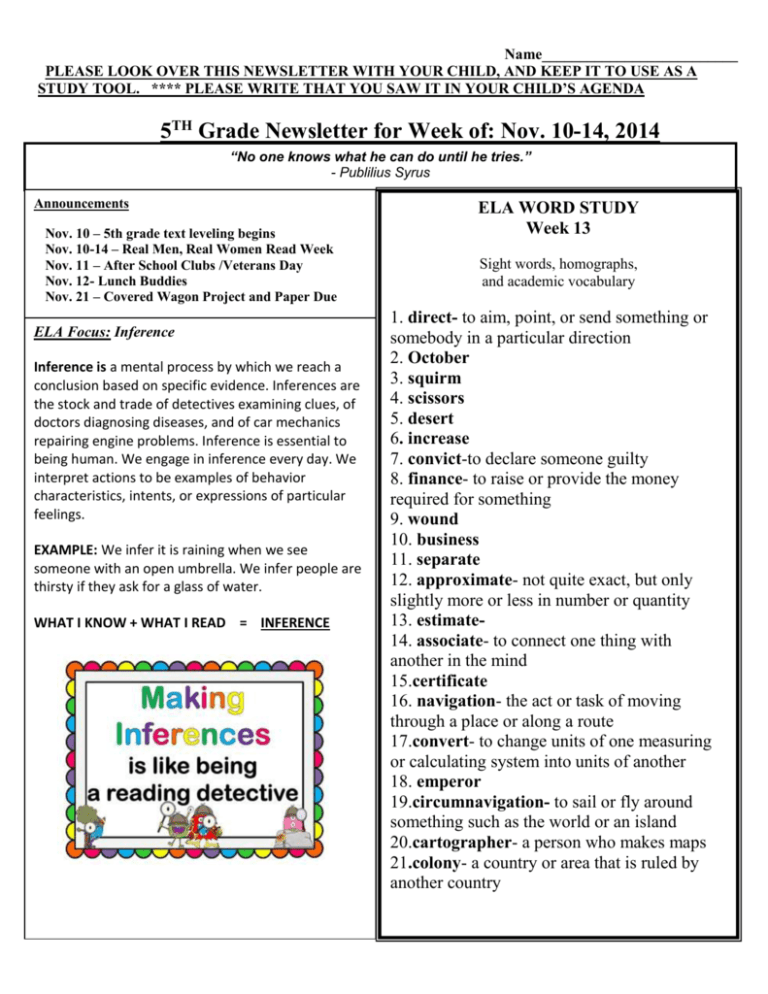
Name__________________________ PLEASE LOOK OVER THIS NEWSLETTER WITH YOUR CHILD, AND KEEP IT TO USE AS A STUDY TOOL. **** PLEASE WRITE THAT YOU SAW IT IN YOUR CHILD’S AGENDA 5TH Grade Newsletter for Week of: Nov. 10-14, 2014 “No one knows what he can do until he tries.” - Publilius Syrus Announcements Nov. 10 – 5th grade text leveling begins Nov. 10-14 – Real Men, Real Women Read Week Nov. 11 – After School Clubs /Veterans Day Nov. 12- Lunch Buddies Nov. 21 – Covered Wagon Project and Paper Due ELA Focus: Inference Inference is a mental process by which we reach a conclusion based on specific evidence. Inferences are the stock and trade of detectives examining clues, of doctors diagnosing diseases, and of car mechanics repairing engine problems. Inference is essential to being human. We engage in inference every day. We interpret actions to be examples of behavior characteristics, intents, or expressions of particular feelings. EXAMPLE: We infer it is raining when we see someone with an open umbrella. We infer people are thirsty if they ask for a glass of water. WHAT I KNOW + WHAT I READ = INFERENCE ELA WORD STUDY Week 13 Sight words, homographs, and academic vocabulary 1. direct- to aim, point, or send something or somebody in a particular direction 2. October 3. squirm 4. scissors 5. desert 6. increase 7. convict-to declare someone guilty 8. finance- to raise or provide the money required for something 9. wound 10. business 11. separate 12. approximate- not quite exact, but only slightly more or less in number or quantity 13. estimate14. associate- to connect one thing with another in the mind 15.certificate 16. navigation- the act or task of moving through a place or along a route 17.convert- to change units of one measuring or calculating system into units of another 18. emperor 19.circumnavigation- to sail or fly around something such as the world or an island 20.cartographer- a person who makes maps 21.colony- a country or area that is ruled by another country Name__________________________ PLEASE LOOK OVER THIS NEWSLETTER WITH YOUR CHILD, AND KEEP IT TO USE AS A STUDY TOOL. **** PLEASE WRITE THAT YOU SAW IT IN YOUR CHILD’S AGENDA Math Focus: Multiplying Decimals Science Focus: Explain how waves, currents, tides, and storms affect the geologic features of the ocean shore zone. It is essential for students to know that the area where the ocean meets the land is called the ocean shore zone. Beaches * The shoreline, or coast, is the area where the land meets the ocean. Barrier islands * Islands are pieces of land surrounded by water on all sides. Islands with sandy beaches are called barrier islands. Estuaries Social Studies Focus: Large-Scale Immigration * All rivers flow into the oceans. *Prior to the 1890’s most immigrants had come from northern and western Europe, but in the late 19th and early 20th centuries they came from increasingly from eastern and southern Europe. * The area where a river meets the ocean is known as an estuary. * The “old” immigrants were from Angle Saxon countries such as England, Ireland, and Germany, where the “new” immigrants were from Italy, the Slavic states of the Balkan Peninsula, and Russia. * Inlets are the water-filled spaces between the barrier islands. *Many of the new immigrants were Catholics or Jews, whereas the old immigrants had been mostly Protestant. * The repeated movement of water is known as a wave. *Opposition to labor unions was, in part, the result of the fear of foreign radicals. Native-born workers feared that new immigrants would take their jobs. *In the 1920’s, immigration was restricted through a quota systems that discriminated against immigrants who arrived after 1890- the “new immigrants”. *Immigrants have made many contributions to the growth and development of the United States. The majority of workers who built the Transcontinental Railroad were the Irish and Chinese immigrants. Inlets Waves Currents * Flowing streams of water that move continually through the ocean in a specific direction are called currents. Tides * This regular rise and fall of waters in oceans and seas is called a tide. Name__________________________ PLEASE LOOK OVER THIS NEWSLETTER WITH YOUR CHILD, AND KEEP IT TO USE AS A STUDY TOOL. **** PLEASE WRITE THAT YOU SAW IT IN YOUR CHILD’S AGENDA



